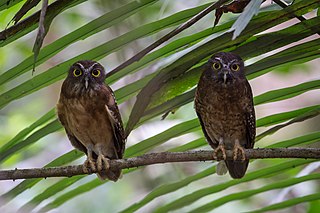
Magnolia champaca, known in English as champak, is a large evergreen tree in the family Magnoliaceae. It was previously classified as Michelia champaca. It is known for its fragrant flowers, and its timber used in woodworking.

The green-bellied hummingbird, also known as the Tepui hummingbird, is a species of hummingbird in the family Trochilidae. It is found in Brazil, Colombia, Guyana, and Venezuela.

The Cozumel emerald is a species of hummingbird in the family Trochilidae. It is endemic to the Mexican island of Cozumel off the Yucatán Peninsula. Its natural habitats are subtropical or tropical dry forest, subtropical or tropical moist lowland forest, and subtropical or tropical moist shrubland. It is threatened by habitat loss.

The golden-tailed sapphire is a species of hummingbird in the family Trochilidae. It is found in Bolivia, Brazil, Colombia, Ecuador, Peru, Trinidad and Tobago, and Venezuela.

The rufous-webbed brilliant is a species of hummingbird in the family Trochilidae. It is found in the Andean foothills of Peru and possibly northwestern Bolivia. Its natural habitats are subtropical or tropical moist lowland forest and subtropical or tropical moist montane forest.

The pink-throated brilliant is a species of hummingbird in the family Trochilidae. It is found in Colombia, Ecuador, and Peru. Its natural habitats are subtropical or tropical moist lowland forest and subtropical or tropical moist montane forest. It is becoming rare due to habitat loss.

The empress brilliant is a species of hummingbird in the family Trochilidae. It is found in Colombia and Ecuador.

The black-throated brilliant is a species of hummingbird in the family Trochilidae. It is found in Brazil, Colombia, Ecuador, and Peru. Its natural habitats are subtropical or tropical moist lowland forest and subtropical or tropical moist montane forest.

The stripe-breasted starthroat is a species of hummingbird in the family Trochilidae.

The fork-tailed woodnymph is a species of hummingbird in the family Trochilidae. It is found in Argentina, Bolivia, Brazil, Colombia, Ecuador, French Guiana, Guyana, Paraguay, Peru, Suriname, Trinidad and Tobago, and Venezuela. Its natural habitats are subtropical or tropical moist lowland forest, subtropical or tropical moist montane forest, and heavily degraded former forest.

The yellow-striped poison frog is a species of frog in the family Dendrobatidae. It is endemic to Colombia. Its natural habitats are subtropical or tropical dry forests, subtropical or tropical moist lowland forests, subtropical or tropical moist montane forests, intermittent freshwater marshes, and plantations.

The Andaman hawk-owl or Andaman boobook is a species of owl in the family Strigidae. It is endemic to the Andaman Islands.

The ochre-bellied boobook is a species of owl in the family Strigidae. It is endemic to Sulawesi, Indonesia. Its natural habitats are subtropical or tropical dry forests and subtropical or tropical moist lowland forests. It is threatened by habitat loss.

The white-winged cotinga is a species of bird in the family Cotingidae. It is endemic to Brazil. Its natural habitat is subtropical or tropical moist lowland forest. It is threatened by habitat loss.
Goeppertia curaraya is a species of flowering plant in the Marantaceae family. It is natve to Ecuador and Colombia. Its natural habitat is subtropical or tropical moist lowland forests.
Goeppertia dodsonii is a species of flowering plant in the Marantaceae family. It is endemic to Ecuador. Its natural habitat is subtropical or tropical moist lowland forests.

Goeppertia ecuadoriana is a species of flowering plant in the Marantaceae family. It is endemic to Ecuador. Its natural habitats are subtropical or tropical moist lowland forests and subtropical or tropical moist montane forests.
Goeppertia gandersii is a species of flowering plant in the Marantaceae family. It is endemic to Napo Province of Ecuador. Its natural habitats are subtropical or tropical moist lowland forests and subtropical or tropical moist montane forests.

Ceratozamia mexicana is a species of plant in the family Zamiaceae.

Epiphyllum cartagense is an epiphytic species of cactus native to Costa Rica and Panama. This species occurs in subtropical and tropical moist lowland forest or montane wet forest at elevations of 600 to 2000 m. The population is stable and the IUCN categorises the species as least concern. International trade is restricted to the conditions of CITES. The specific epithet cartagense refers to the locality Cartago in Costa Rica.


















